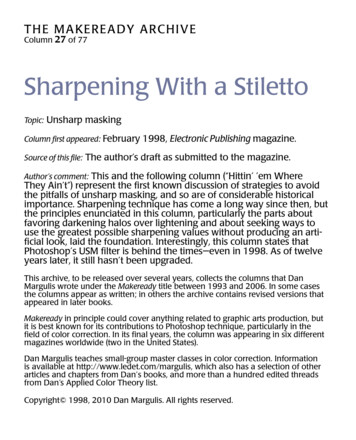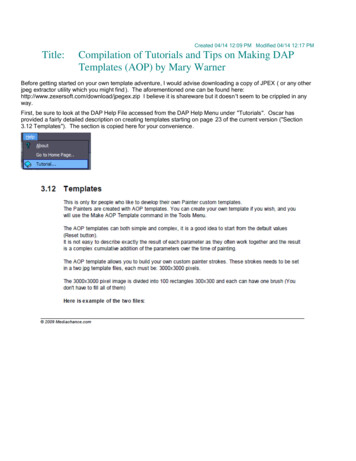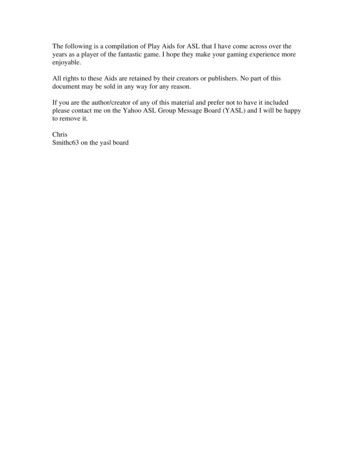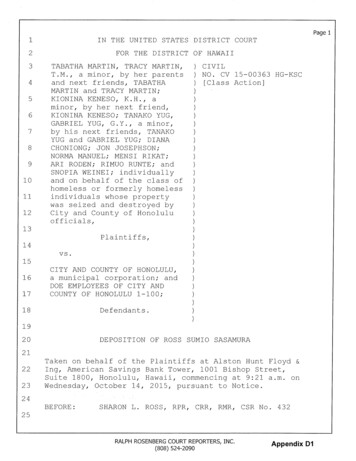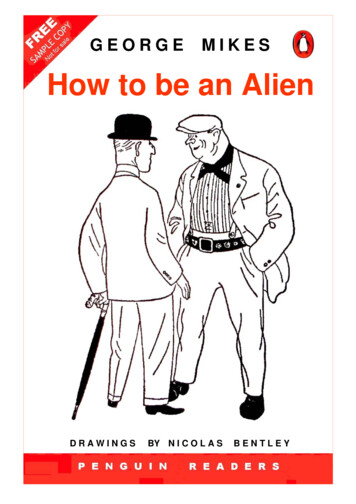
Transcription
Constructing the Past1The Darker Side of Martin LutherEmily ParasIf we wish to find a scapegoat on whose shoulders we maylay the miseries which Germany has brought upon theworld-I am more and more convinced that the worst evilgenius of that country is not Hitler or Bismarck orFrederick the Great, but Martin Luther.-Reverend William Ralph Inge, 1944.Martin Luther is remembered as one of the most famous religious figures inhistory, considered to be the founder of Protestantism. However, there was a lesserknown side of him, one that was dark and full of hatred. Unknown to popularknowledge, Luther wrote a treatise in 1543 titled On the Jews and Their Lies. In this65,000-word document, he repeatedly attacks the Jews. The consequences of this treatisewere far reaching, even extending into the present day, as his writings continue to bereproduced in pamphlets by neo-Nazi and anti-Semitic groups. More devastating, hiswritings were circulated during the most horrifying event of the 20th century: theHolocaust. Hitler himself named Luther as one of history’s greatest reformers in hisnovel, Mein Kampf. How much did Luther’s writings affect Hitler and the Nazis? Thispaper will serve as evidence of how difficult it is to accurately recount past events,especially ones that involve unpleasant aspects of world history. I will examine this topicusing primary sources written by Luther and Hitler and official documents concerning theInternational military tribunal at Nuremburg to explore Luther’s influence on Hitler.Secondary sources such as books written by Peter Wiener, Eliot Wheaton, and DanielGoldhagen, will also be considered in order to compare my findings to those of otherscholars.
2Emily ParasLuther’s attitude toward the Jews appeared to change over his life. His earlierattitudes seemed were sympathetic towards the Jews. The most convincing evidence ofthis is his publication in 1523 of the essay That Jesus Christ Was Born a Jew. In it, heurges Christians to treat Jews more gently, and condemns those who treat them asinhuman. Specifically he accuses Catholics of being unfair to them, arguing that,If I had been a Jew and had seen such dolts and blockheadsgovern and teach the Christian faith, I would sooner havebecome a hog than a Christian. They have dealt with theJews as if they were dogs rather than human beings; theyhave done little else than deride them and seize theirproperty.1This quote will stand out later in stark contrast to Luther’s later works about the Jews.He even goes so far as to write, “If we really want to help them, we must be guided in ourdealings with them we must receive them cordially, and permit them to hear ourChristian teachings and witness our Christian life.”2 Lutheran theologians who excuseLuther’s later anti-Semitic attitudes, called “apologists,” often use these two quotes toprove that Luther originally was friendly to the Jews. They offer excuses such as his oldage and declining health as reasons why he adopted a negative attitude toward Jews.However, as I more thoroughly examined the primary source itself, I have come tobelieve that the real “truth,” if this can be found, is that Luther was anti-Semitic all along,and only revealed his true colors after becoming agitated and frustrated with the Jews.As Luther explains, he was prompted to write this earlier essay, That Jesus ChristWas Born a Jew, in response to a lie that was circulating about him. This lie was that hedid not believe that Mary was a virgin at the time of Jesus’s birth. Through this book, he1Martin Luther, That Jesus Christ was Born a Jew, ed. Helmut T. Lehmann, trans. Walther I.Brandt, vol. 45 (Philadelphia: Fortress Press, 1962), 200.2Ibid., 229.
Constructing the Past3was not addressing the Jews, but Christians who supposedly spread this lie about him.However, he does reveal another, more minor objective, when he writes: “that I mightperhaps also win some Jews to the Christian faith.”3 A secondary source written byAndreas Pangritz supports my theory: “A close reading of Luther’s statements will provethat as early as 1523 he was interested in the Jews simply as objects of conversion thereis much more continuity than apologists of the Reformer would admit between Luther’sallegedly pro-Jewish attitude in 1523 and the explicitly anti-Semitic writings of his lateryears.”4 Lutherans are not proud of Luther’s anti-Semitic views. One way they haveattempted to salvage his reputation is by alleging that he only became anti-Semitic whenhe grew older, perhaps due to psychological reasons. Through this and other excusesthey have tried to hide the truth, in order to keep this embarrassing aspect of their religionsecret.Another event that demonstrates the continuity of Luther’s views throughout hislife occurred in August of 1536. Elector John Frederick of Saxony, one of Luther’sbiggest supporters, decreed that all Jews were to be driven out of his electorate. Josel vonRosheim, who at the time was considered the spokesman for the Jews, appealed to Lutherfor help. At this time Luther was considered to be friendly towards the Jews, especiallybecause of his book, That Jesus Christ was Born a Jew. However, Luther refused, muchto the surprise of von Rosheim. According to Heiko A. Oberman, a renowned biographerof Luther, “even today this refusal is often judged to be the decisive turning point in3Ibid., 200.Andreas Pangritz, “Once More: Martin Luther and the Jews,” Remembering for the Future: TheHolocaust in an Age of Genocide 2 (2001): 604.4
4Emily ParasLuther’s career from friendliness to hostility toward the Jews.”5 During this time Luthertried to convert the Jews, but to no avail. He became frustrated with them, especiallywhen he received a treatise from Count Wolfgang Schlick of Falkenau, which suggestedthat Jews were attempting to convert Christians to Judaism. Luther records this asjustification for writing On the Jews and Their Lies, “so that I might be found amongthose who opposed such poisonous activities of the Jews and who warned the Christiansto be on their guard against them.”6 I believe this event pushed Luther over the edge, andthus began his explicitly anti-Semitic writing.In 1543 Luther published his infamous On the Jews and Their Lies. His mainarguments can be divided into four major parts. In the first part, Luther attacked what heconsidered the Jews’ “false boasts,” mainly their lineage and covenant of circumcision.In the second part, he debated key biblical passages. Third, he focused on the grossestmedieval superstitions concerning the Jews are the focus of the third part. The fourth,and final, part included Luther’s recommendations for actions concerning the Jews. Forthe purposes of this paper, the fourth part of this treatise will be primarily examined. Itcontains the most evidence for Luther’s anti-Semitic views, and the Nazis quoted Luthermost often from this section.Throughout the treatise he decried the Jews, claiming they were “an idle and lazypeople, such a useless, evil, pernicious people, such blasphemous enemies of God.”7 Heespecially stressed the commonly held belief during this time that because Jews madetheir livelihood through usury, they were able to steal and rob from others: “we let them5 Heiko A. Oberman, Luther: Man between God and the Devil (New Haven and London: YaleUniversity Press, 1989), 293.6Martin Luther, On the Jews and Their Lies, ed. Helmut T. Lehmann, trans. Martin H. Bertram,vol. 47, (Philadelphia: Fortress Press, 1971), 137.7Ibid., 276.
Constructing the Past5get rich on our sweat and blood, while we remain poor and they suck the marrow fromour bones.”8 After ranting and raving about the Jews, he gave his advice to his fellowChristians. This advice is in the form of an eight-point plan to deal with the Jews. Thisplan is most often referred to when scholars attempt to connect Luther with Hitler.First, Luther told Christians to “set fire to their synagogues or schools and to buryand cover with dirt whatever will not burn.”9 This advice was implemented by the Nazisduring the anti-Semitic pogrom known as Kristallnacht, which will be elaborated on laterin this paper. Second, he recommended that “their houses also be razed and destroyed.”10Third, he advised that “all their prayer books and Talmudic writings, in which suchidolatry, lies, cursing, and blasphemy are taught, be taken from them.”11 Fourth, hedeclared that “rabbis be forbidden to teach henceforth on pain of loss of life and limb.”12Fifth, he urged that “safe-conduct on the highways be abolished completely forthe Jews.”13 Sixth, he wrote that “usury should be prohibited to them, and that all cashand treasure of silver and gold be taken from them and put aside for safekeeping.”14 Thisrecommendation directly contradicted one of Luther’s earlier statements defending Jewsin his treatise, That Jesus Christ was Born a Jew, and was also taken by the Nazis.Acting on this advice during the Third Reich, the Nazis often stole money and valuablesfrom the Jews, especially after they were sent to concentration camps. Seventh, herecommended “putting a flail, an ax, a hoe, a spade, a distaff, or a spindle into the8Ibid., 273.Ibid., 268.10Ibid., 269.11Ibid.12Ibid.13Ibid., 270.14Ibid.9
6Emily Parashands letting them earn their bread in the sweat of their brow.”15 The Nazis also tookthis advice when they implemented concentration camps, where Jews were forced intohard manual labor.Finally, he wrote that “if we wish to wash our hands of the Jews’ blasphemy andnot share in their guilt, we have to part company with them. They must be driven fromour country like mad dogs.”16 This also directly contradicted Luther’s earlier statementcriticizing the Catholics treatment of the Jews. This advice was taken by the Nazis aswell, but they took it a step farther when they implemented their “final solution.”Is it “true” that Luther was anti-Semitic? I have to answer with a resounding yes.However, I think the term “anti-Judaic” better describes Luther, considering the fact that“anti-Semitic” is a modern word, first used in the mid-19th century. Anti-Semitism alsoconcerns the issue of race, whereas Luther’s objection to the Jews had nothing to do withtheir race, but their religious beliefs.In trying to uncover the “truth” about Luther’s views, the main problem Iencountered was the depth of his writings. Luther’s works fill volumes upon volumes ofbooks. To read all of them would be nearly impossible, especially in my case where Ihad a limited amount of time to research. Therefore I read only the two books that mostdirectly impacted this paper. There may be other important writings of his on this matterthat I have not been able to uncover due to time constraints. Also, my readings ofLuther’s work are dependent on the translated version. How much should I trust that thetranslator was accurate? On balance, however, I believe the evidence I did uncover isextensive enough to prove that Luther was anti-Semitic.1516Ibid., 272.Ibid., 292.
Constructing the Past7The influence of Luther’s writings on the Nazis was quite profound. Several ofHitler’s top advisors quoted Luther, as well as Hitler himself. In the chapter entitled“The Beginning of My Political Activity” from Mein Kampf, Hitler’s infamous book, hediscussed the “great warriors” in this world, who:though not understood by the present, are neverthelessprepared to carry the fight for their ideas and ideals to theirend to them belong, not only the truly great statesmen,but all other great reformers as well. Beside Frederick theGreat stands Martin Luther.17Hitler also quoted Luther during one of his speeches: “I do insist on the certainty thatsooner or later-once we hold power the German church established without a Popeand without the Bible, and Luther, if he could be with us, would give us his blessing.”18Hitler’s top officials soon followed his example, beginning with Bernhard Rust.Bernhard Rust, Hitler’s Education Minister, was quoted in the VolkischerBeobachter as saying: “Since Martin Luther closed his eyes, no such son of our peoplehas appeared again we shall be the first to witness his reappearance I think the time ispast when one may not say the names of Hitler and Luther in the same breath. Theybelong together; they are of the same old stamp.”19 This quote by Rust demonstrates thathe was influenced by Luther, and believed his teachings paralleled Hitler’s. In arguingthat they “belong together” he tried to justify Hitler’s actions through Luther’s beliefs.Hans Hinkel, a journalist and ministerial official during the Nazi regime, was alsoinfluenced by Luther. He paid tribute to him during his acceptance speech of Goebbels’sChamber of Culture and Propaganda Ministry, saying that “through his acts and his17Adolf Hitler, Mein Kampf (Boston and New York: Houghton Mifflin Company, 1971), 213.Peter F. Wiener, Martin Luther: Hitler’s Spiritual Ancestor (Cranford, New Jersey: AmericanAtheist Press, 1999), ix-x.19Richard Steigmann-Gall, The Holy Reich: Nazi Conceptions of Christianity, 1919-1945 (NewYork: Cambridge University Press, 2003), 136-7.18
8Emily Parasspiritual attitude he began the fight which we still wage today; with Luther the revolutionof German blood and feeling against alien elements of the Volk was begun.”20 Again,this quote demonstrates that Luther’s works were used to justify Nazi actions. In thiscase, Hinkel alluded to the fact that Luther began the revolution that the Nazis continued.One of the most vehement anti-Semitic Nazis during this time period was JuliusStreicher, editor of the Nazi newspaper Der Sturmer. After the end of World War II, hewas arrested and accused of committing war crimes. During his trial, he claimed that“Dr. Martin Luther would very probably sit in my place in the defendants’ dock today, ifthis book [On the Jews and Their Lies] had been taken into consideration by theProsecution.”21 This statement from Streicher shows that he believed Luther was just asguilty as himself, and he uses Luther to defend himself against the accusations beingmade against him. On October 1st, 1946, he was found guilty of crimes against humanity,and he was executed on October 16th of that year.Not only did Luther influence important Nazi officials, but it has been suggestedthat he also helped inspire certain major events during the Third Reich. One of theseevents was Kristallnacht. On this night, November 10th, 1938, Nazis killed Jews,shattered glass windows, and destroyed hundreds of synagogues. Bishop Martin Sasse, aleading Lutheran churchman, immediately saw the connection between this event andLuther’s writing. Shortly after the event, he published a compendium of Luther’s antiSemitic works. In the foreword, he applauded the event, especially since it occurred onLuther’s birthday. He also wrote that the German people should pay attention to the20Ibid., 137.The International Military Tribunal, Trial of the Major War Criminals, vol. 12, (Nuremburg,Germany, 1947), 318.21
Constructing the Past9writings of Luther, who was the “greatest anti-Semite of this time, the warner of hispeople against the Jews.”22 Another event in which Luther’s presence was felt was theNuremberg rallies. During the rallies, a copy of On the Jews and Their Lies was publiclyexhibited in a glass case, and the city of Nuremberg presented a first edition to JuliusStreicher.Another Nazi propaganda pamphlet that cited Luther was titled “Why the AryanLaw? A Contribution to the Jewish Question.” It was written for mass circulation by Dr.E.H. Schulz and Dr. R. Frercks in 1934. It summarized the “Aryan Law,” which wasimplemented early in Hitler’s rule with the intent of driving Jews out of the professions.This pamphlet quoted Luther in an attempt to justify Nazi racial legislation. The quote isfrom On the Jews and Their Lies: "They [Jews] hold we Christians captive in our ownland. They have seized our goods by their cursed usury, they mock and insult us becausewe work."23 Following this, Schulz and Frercks elaborated on Luther’s ideas andwritings, and the connections it had with Nazi legislation. Schulz and Frercks ended thepamphlet by writing that “[i]f in the coming days the Jewish race is driven out of the nonJewish world It has made clear to them for all time the value of maintaining the purityof race and blood in clear, understandable and unforgettable ways.”24 Even thoughLuther does not mention race in his writings of the Jews, the Nazis were able to twist andwarp his writings to support their beliefs.Articles written during the Third Reich also used Luther to support their beliefs.Kurt Hilmar Eitzen’s article written in the party monthly for propagandists, entitled “Ten22Daniel Goldhagen, Hitler’s Willing Executioners, (New York: Vintage, 1997), 265.Schulz and Frercks. Accessed from Ibid.23
10Emily ParasResponses to Jewish Lackeys,” is one example. This article presented counterargumentsto the most common objections the Nazis encountered. These counterarguments weresupposed to be used in everyday conversations among common citizens. Luther isquoted to counter argument number 5: “Argument 5: ‘Mr. Levi is not a Jew, since he hasbeen baptized!’ — Counterargument: ‘I have no desire to convert the Jews,’ MartinLuther wrote, ‘since that is impossible.’ A Jew remains a Jew.”25 This is yet anotherinstance of the Nazis’ misuse of Luther’s works. Luther very often contradicted himselfon the possibility of converting Jews. However, he wrote that “whenever a Jew issincerely converted, he should be handed one hundred, two hundred, or three hundredflorins.”26 From this statement, one can conclude that Luther believed Jews could beconverted. His last sentence in his treatise On the Jews and Their Lies, deals with thepossibility of conversion: “May Christ, our dear lord, convert them mercifully.”27 Again,Luther might have seen the possibility of Jews converting to Christianity. However, thisarticle uses Luther’s work to support the Nazis’ belief that Jews could not convertbecause Judaism is a race. The idea of race and the purity of blood was one fundamentalbelief of the Nazi party. However, not once does Luther mention the idea that Jews werea separate race. The article takes Luther’s quote completely out of context, distorting itto support their claims.Luther also had an impact on the Lutherans living in Germany during the ThirdReich. In 1941, Hitler declared his intent to reform the Evangelical Church andcoordinate it with the state. On November 13th, a big rally was held in support of thisidea. The movement’s leader, Reinhardt Krause, delivered a speech which dealt with25Eitzen, Kurt accessed from tmLuther, On the Jews and Their Lies, 270.27Ibid., 306.26
Constructing the Past11“the tasks of a Reich Church in the Spirit of Dr. Martin Luther.”28 Lutherans throughoutGermany embraced this idea, and in general the majority did not oppose Hitler and hispolicies. This may be hard to understand in retrospect, but author William Shirerexplains “it is difficult to understand the behavior of most German Protestants in the firstNazi years unless one is aware of the influence of Martin Luther. The greatfounder was both a passionate anti-Semite and a ferocious believer in absoluteobedience to political authority.”29 This influence on Lutherans led many of them toaccept the Nazis’ anti-Semitic views, and to blindly obey Hitler and other authorities asLuther had preached.There was one group of dissent, the “Confessing Church,” which was founded in1934 by a group of pastors. These pastors opposed Hitler’s idea to create a ReichChurch. While it has been suggested by many scholars that this group proved that not allLutherans went along with Hitler, the evidence does not support this claim. Author EliotWheaton writes that the Confessing Church “never ceased to resist Nazi encroachmentsin the religious sphere. Outside that sphere they made little effort to oppose theprogress of Nazi tyranny and protect its victims.”30 This group was opposed to the Nazis’interfering in their church, but they were not opposed, or at least publicly, with the Nazi’sethics. This is not to say that there were not Lutherans who resisted the Nazis, but it istrue that the majority were compliant.How much did Luther actually influence the Nazis? Scholars are split on thisissue. Author Robert Waite argues that “Luther would have been appalled by the Third28Eliot B. Wheaton, Prelude to Calamity: The Nazi Revolution 1933-35 (Garden City, New York:Doubleday and Company, Inc., 1968), 365.29William L. Shirer, The Rise and Fall of the Third Reich (New York: Simon and Schuster, 1960),236.30Wheaton, 367.
12Emily ParasReich he would have denounced Hitler would have been among the first executed.”31Yet, he also concedes that “we must also say that the great religious reformer didunwittingly help pave the way for Hitler.”32 In this realm, “truth” is harder to find. Firstof all, the actual pamphlets that were written in Germany during the Third Reich arestored in archives that are not easily accessible. These pamphlets are the primarydocuments that would offer concrete evidence of Luther’s influence. Another difficultyto discerning the truth is the actions of the Lutheran churches. While Luther did havemany positive contributions, this does not excuse or compensate for his negativecontributions to society. I was raised as a Lutheran, and yet I never learned of Luther’santi-Semitism. Now that I think about it, it makes sense that the Lutheran Church wouldwant to keep Luther’s anti-Semitism a secret. There are also very few secondary sourcesthat connect Luther and Hitler, and so I was not able to use a lot of these sources to aidmy investigation into the truth of my claim.In the end, I believe I have uncovered a substantial amount of evidence thatproves that Martin Luther was anti-Semitic. However, I believe that I have notuncovered enough truth to thoroughly support my claim that Luther significantlyinfluenced Hitler and the Nazis. Perhaps, in the future, with more time to investigate andresearch sources, my claim will be proven.249.31Robert G.L. Waite, The Psychopathic God Adolf Hitler (New York: Basic Books, Inc., 1977),32Ibid., 249.
knowledge, Luther wrote a treatise in 1543 titled On the Jews and Their Lies. In this 65,000-word document, he repeatedly attacks the Jews. The consequences of this treatise . Through this book, he 1 Martin Luther, That Jesus Christ was Born a Jew, ed. Helmut T. Lehmann, trans. Walther I. Brandt, vol. 45 (Philadelphia: Fortress Press, 1962), 200.


